小学英语新外研版(一起)三年级上册M5U1 教案1
- 格式:doc
- 大小:30.50 KB
- 文档页数:4
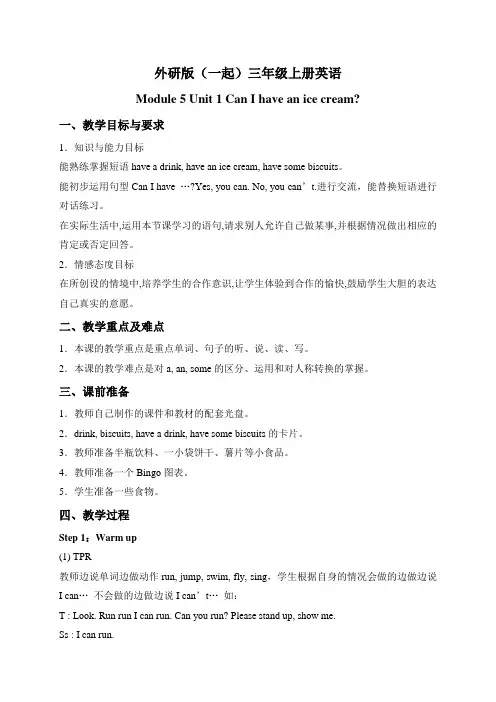
外研版(一起)三年级上册英语Module 5 Unit 1 Can I have an ice cream?一、教学目标与要求1.知识与能力目标能熟练掌握短语have a drink, have an ice cream, have some biscuits。
能初步运用句型Can I have …?Yes, you can. No, you can’t.进行交流,能替换短语进行对话练习。
在实际生活中,运用本节课学习的语句,请求别人允许自己做某事,并根据情况做出相应的肯定或否定回答。
2.情感态度目标在所创设的情境中,培养学生的合作意识,让学生体验到合作的愉快,鼓励学生大胆的表达自己真实的意愿。
二、教学重点及难点1.本课的教学重点是重点单词、句子的听、说、读、写。
2.本课的教学难点是对a, an, some的区分、运用和对人称转换的掌握。
三、课前准备1.教师自己制作的课件和教材的配套光盘。
2.drink, biscuits, have a drink, have some biscuits的卡片。
3.教师准备半瓶饮料、一小袋饼干、薯片等小食品。
4.教师准备一个Bingo图表。
5.学生准备一些食物。
四、教学过程Step 1:Warm up(1) TPR教师边说单词边做动作run, jump, swim, fly, sing,学生根据自身的情况会做的边做边说I can…不会做的边做边说I can’t…如:T : Look. Run run I can run. Can you run? Please stand up, show me.Ss : I can run.T : Swim swim.Ss : I can swim.\ I can’t swim.…T : Can you sing the song “Row Your Boat”?Ss : Yes, I can.(2) Sing the song “Row Your Boat” together.Step 2:Presentation and practice(1)Learn the phrase: have a drink.教师做出口渴的样子,并且说Oh, I’m thirsty. Can I have a drink, please? 教师喝一点饮料后,问学生Do you want to drink?Read the word “drink”. (Show the card “drink”.)Read the phrase “have a drink” in groups. (Show the card “have a drink”.) Translate it in Chinese.(2)Use the real drink to teach the sentences:Can I have a drink, please? Yes, you can. No, you can’t.问学生谁想喝饮料Who wants to have a drink? 鼓励学生用Can I have a drink, please?来询问,对表达清楚的学生,教师说Yes, you can.并给他一小杯饮料。
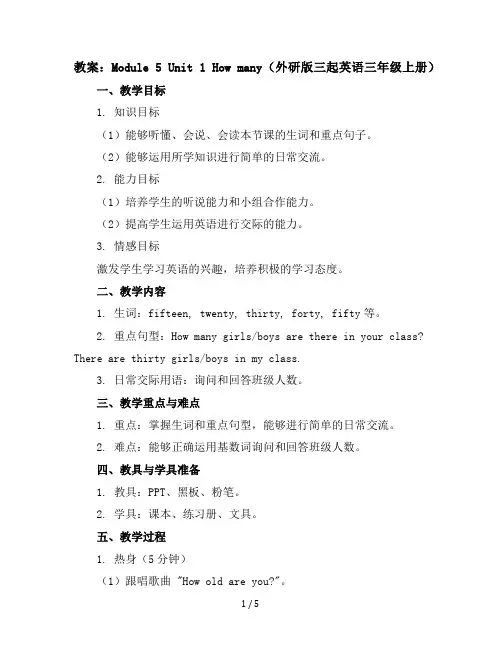
教案:Module 5 Unit 1 How many(外研版三起英语三年级上册)一、教学目标1. 知识目标(1)能够听懂、会说、会读本节课的生词和重点句子。
(2)能够运用所学知识进行简单的日常交流。
2. 能力目标(1)培养学生的听说能力和小组合作能力。
(2)提高学生运用英语进行交际的能力。
3. 情感目标激发学生学习英语的兴趣,培养积极的学习态度。
二、教学内容1. 生词:fifteen, twenty, thirty, forty, fifty等。
2. 重点句型:How many girls/boys are there in your class? There are thirty girls/boys in my class.3. 日常交际用语:询问和回答班级人数。
三、教学重点与难点1. 重点:掌握生词和重点句型,能够进行简单的日常交流。
2. 难点:能够正确运用基数词询问和回答班级人数。
四、教具与学具准备1. 教具:PPT、黑板、粉笔。
2. 学具:课本、练习册、文具。
五、教学过程1. 热身(5分钟)(1)跟唱歌曲 "How old are you?"。
(2)老师出示数字卡片,学生快速说出对应的英文数字。
2. 导入(10分钟)(1)老师出示一个班级的图片,引导学生思考如何用英语描述班级人数。
(2)学生尝试用英语表达,老师给予鼓励和指导。
3. 呈现新课(15分钟)(1)老师出示生词卡片,引导学生学习并朗读。
(2)通过简单的句子练习,让学生掌握重点句型。
4. 练习与巩固(10分钟)(1)小组活动:学生分成小组,用所学知识互相询问班级人数,并记录在表格中。
(2)老师选取小组进行汇报,给予评价和指导。
5. 课堂小结(5分钟)六、板书设计板书设计如下:How many girls/boys are there in your class?There are thirty girls/boys in my class.生词:fifteen, twenty, thirty, forty, fifty等。
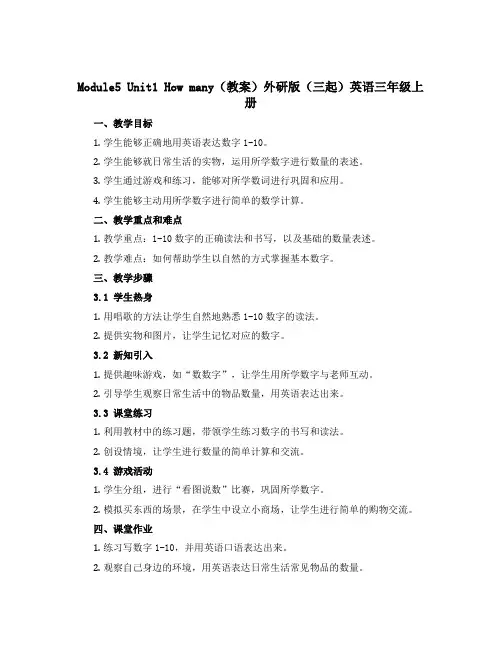
Module5 Unit1 How many(教案)外研版(三起)英语三年级上册一、教学目标1.学生能够正确地用英语表达数字1-10。
2.学生能够就日常生活的实物,运用所学数字进行数量的表述。
3.学生通过游戏和练习,能够对所学数词进行巩固和应用。
4.学生能够主动用所学数字进行简单的数学计算。
二、教学重点和难点1.教学重点:1-10数字的正确读法和书写,以及基础的数量表述。
2.教学难点:如何帮助学生以自然的方式掌握基本数字。
三、教学步骤3.1 学生热身1.用唱歌的方法让学生自然地熟悉1-10数字的读法。
2.提供实物和图片,让学生记忆对应的数字。
3.2 新知引入1.提供趣味游戏,如“数数字”,让学生用所学数字与老师互动。
2.引导学生观察日常生活中的物品数量,用英语表达出来。
3.3 课堂练习1.利用教材中的练习题,带领学生练习数字的书写和读法。
2.创设情境,让学生进行数量的简单计算和交流。
3.4 游戏活动1.学生分组,进行“看图说数”比赛,巩固所学数字。
2.模拟买东西的场景,在学生中设立小商场,让学生进行简单的购物交流。
四、课堂作业1.练习写数字1-10,并用英语口语表达出来。
2.观察自己身边的环境,用英语表达日常生活常见物品的数量。
五、教学反思本课程主要依靠游戏和情景创设帮助学生轻松掌握基本数字,提高英语口语表述能力。
教师在设计游戏和活动时,要注重趣味性和实际效果。
在教学过程中,需要及时发现学生的不足,为学生提供有效的补充辅助和指导,促进学生的学习进步。
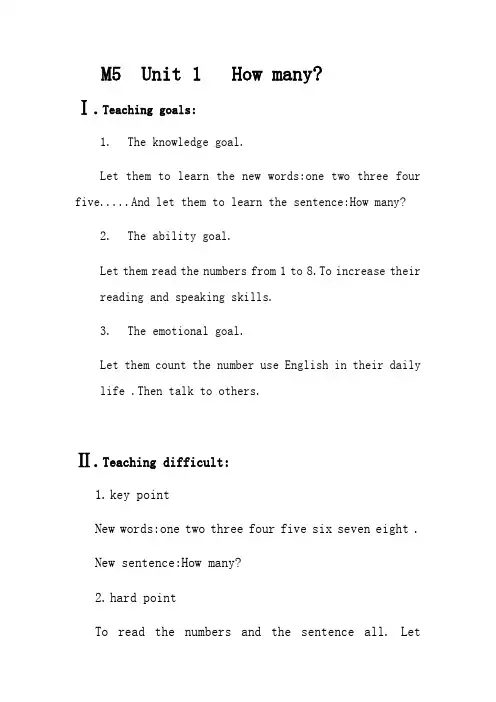
M5 Unit 1 How many?Ⅰ.Teaching goals:1.The knowledge goal.Let them to learn the new words:one two three four five.....And let them to learn the sentence:How many?2.The ability goal.Let them read the numbers from 1 to 8.To increase their reading and speaking skills.3.The emotional goal.Let them count the number use English in their daily life .Then talk to others.Ⅱ.Teaching difficult:1.key pointNew words:one two three four five six seven eight .New sentence:How many?2.hard pointTo read the numbers and the sentence all. Leteveryone can read them.Ⅲ.Teaching steps:Step 1:Lead-in:Sing a song.(please stand up)Step 2:Review the numbers with PPT.One two three four five six seven eight.(纠正孩子们的发音)Step 3:Look and see which number can you read?Please hands up.S1:two S2:four S3:seven.......Step 4:Teach them the number with difficult ways.(加上身体动作举手、抬脚、起立)Step 5:Now let’s count the number.there is something in my packet,let’s count it together.(8个棒棒糖、三朵花、五朵小花)Step 6:Play a game:Guess the numbers,How many ?PPT设计一个框,孩子们猜猜里面有几个事物,举手猜猜,猜对的孩子得一面红旗。
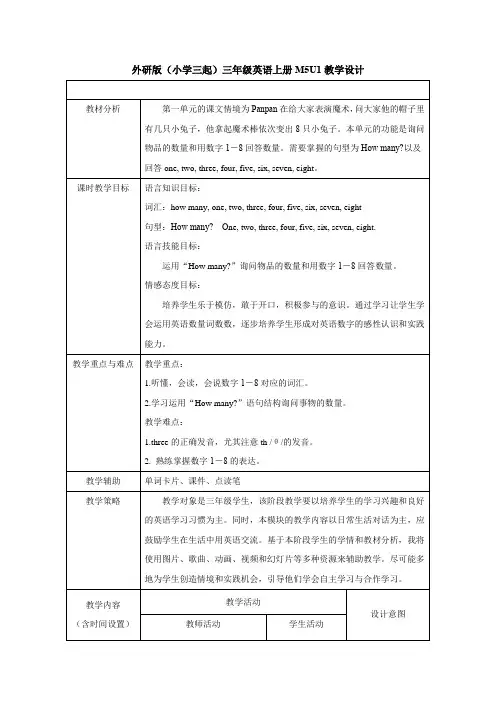
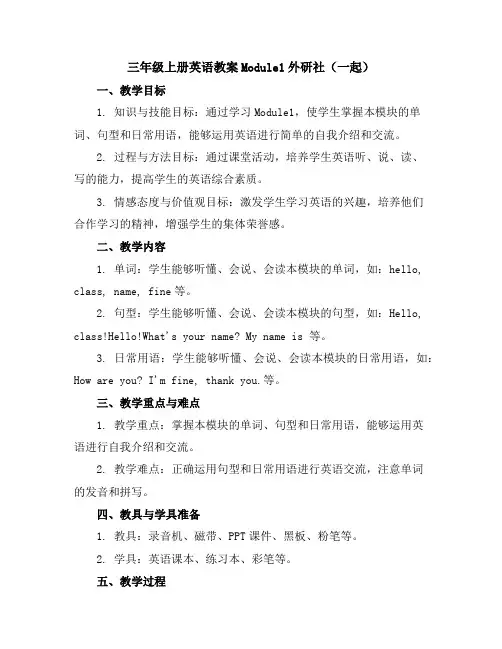
三年级上册英语教案Module1外研社(一起)一、教学目标1. 知识与技能目标:通过学习Module1,使学生掌握本模块的单词、句型和日常用语,能够运用英语进行简单的自我介绍和交流。
2. 过程与方法目标:通过课堂活动,培养学生英语听、说、读、写的能力,提高学生的英语综合素质。
3. 情感态度与价值观目标:激发学生学习英语的兴趣,培养他们合作学习的精神,增强学生的集体荣誉感。
二、教学内容1. 单词:学生能够听懂、会说、会读本模块的单词,如:hello, class, name, fine等。
2. 句型:学生能够听懂、会说、会读本模块的句型,如:Hello, class!Hello!What's your name? My name is 等。
3. 日常用语:学生能够听懂、会说、会读本模块的日常用语,如:How are you? I'm fine, thank you.等。
三、教学重点与难点1. 教学重点:掌握本模块的单词、句型和日常用语,能够运用英语进行自我介绍和交流。
2. 教学难点:正确运用句型和日常用语进行英语交流,注意单词的发音和拼写。
四、教具与学具准备1. 教具:录音机、磁带、PPT课件、黑板、粉笔等。
2. 学具:英语课本、练习本、彩笔等。
五、教学过程1. 热身活动:播放英语歌曲,营造英语学习氛围,激发学生学习兴趣。
2. 新课导入:通过图片、实物等展示本模块的单词,引导学生学习。
3. 课堂讲解:讲解单词、句型和日常用语的含义和用法,进行示范和指导。
4. 课堂练习:组织学生进行听、说、读、写的练习,巩固所学知识。
6. 课后作业:布置适当的作业,巩固所学知识。
六、板书设计1. Module12. 内容:单词、句型、日常用语3. 设计:清晰、简洁、有条理七、作业设计1. 听力作业:听录音,跟读单词和句子。
2. 口语作业:用英语进行自我介绍和交流。
3. 写作作业:抄写单词和句子,进行简单的英语写作。
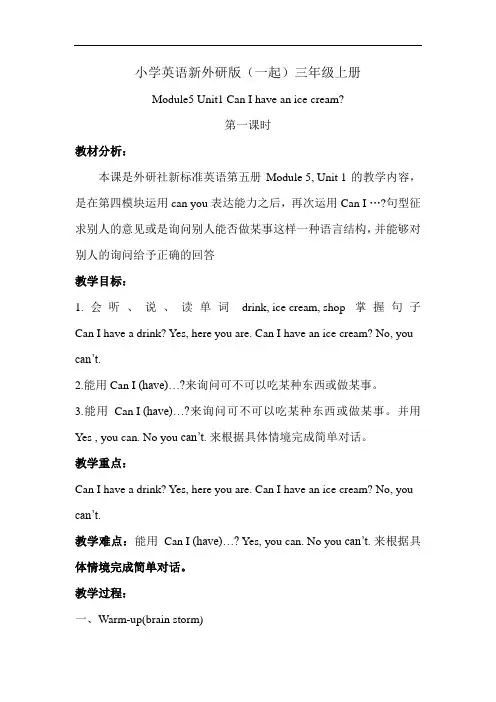
小学英语新外研版(一起)三年级上册Module5 Unit1 Can I have an ice cream?第一课时教材分析:本课是外研社新标准英语第五册Module 5, Unit 1的教学内容,是在第四模块运用can you表达能力之后,再次运用Can I …?句型征求别人的意见或是询问别人能否做某事这样一种语言结构,并能够对别人的询问给予正确的回答教学目标:1.会听、说、读单词drink, ice cream, shop 掌握句子Can I have a drink? Yes, here you are. Can I have an ice cream? No, you can’t.2.能用Can I (have)…?来询问可不可以吃某种东西或做某事。
3.能用Can I (have)…?来询问可不可以吃某种东西或做某事。
并用Yes , you can. No you can’t.来根据具体情境完成简单对话。
教学重点:Can I have a drink? Yes, here you are. Can I have an ice cream? No, you can’t.教学难点:能用Can I (have)…? Yes, you can. No you can’t.来根据具体情境完成简单对话。
教学过程:一、Warm-up(brain storm)Let students say out sports and food. One students can say only one word, and can’t repeat others’ answer. The more the better.二、lead in (free talk)T: we can do many sports on the playground. Look this is a basketball. I c an play basketball. ( The teacher show the example and do the action.) T: Can you play basketball? S: Yes, I can.What sports can you do? Please choose one, say a sentence and do the act ion. (学生可以选择任何一种运动,向同学介绍,边介绍边做动作。
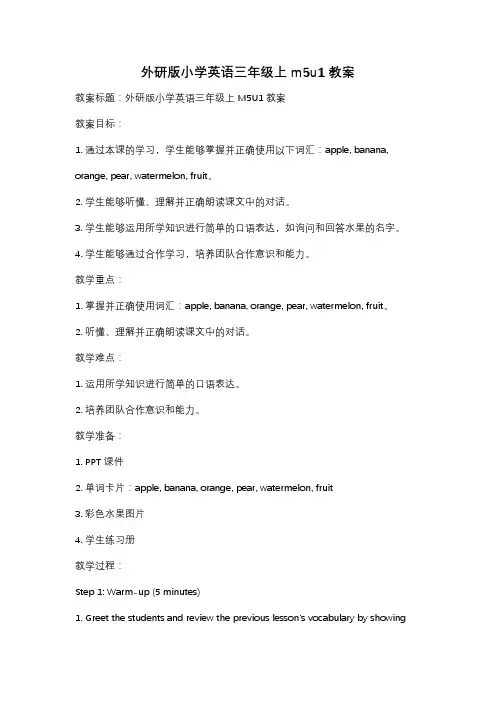
外研版小学英语三年级上m5u1教案教案标题:外研版小学英语三年级上M5U1教案教案目标:1. 通过本课的学习,学生能够掌握并正确使用以下词汇:apple, banana, orange, pear, watermelon, fruit。
2. 学生能够听懂、理解并正确朗读课文中的对话。
3. 学生能够运用所学知识进行简单的口语表达,如询问和回答水果的名字。
4. 学生能够通过合作学习,培养团队合作意识和能力。
教学重点:1. 掌握并正确使用词汇:apple, banana, orange, pear, watermelon, fruit。
2. 听懂、理解并正确朗读课文中的对话。
教学难点:1. 运用所学知识进行简单的口语表达。
2. 培养团队合作意识和能力。
教学准备:1. PPT课件2. 单词卡片:apple, banana, orange, pear, watermelon, fruit3. 彩色水果图片4. 学生练习册教学过程:Step 1: Warm-up (5 minutes)1. Greet the students and review the previous lesson's vocabulary by showingflashcards or pictures of fruits.2. Sing a fruit song together to activate students' prior knowledge and create a lively atmosphere.Step 2: Presentation (10 minutes)1. Introduce the new vocabulary words by showing the flashcards or pictures of fruits. Teach the pronunciation and meaning of each word.2. Use real fruits or pictures of fruits to elicit the names of the fruits from the students.3. Practice the pronunciation and spelling of the new words together as a class. Step 3: Listening and Speaking (15 minutes)1. Play the audio of the dialogue in M5U1 and ask the students to listen carefully.2. Have the students repeat the dialogue after the audio, focusing on correct pronunciation and intonation.3. Divide the students into pairs and have them practice the dialogue together.4. Choose a few pairs to perform the dialogue in front of the class.Step 4: Group Activity (15 minutes)1. Divide the class into small groups and distribute the colored fruit pictures to each group.2. In their groups, students take turns asking and answering questions about the fruits using the sentence pattern "What fruit do you have? I have a/an _______." Encourage them to use complete sentences.3. Monitor the groups and provide assistance as needed.4. Ask each group to choose a representative to share their answers with the class.Step 5: Consolidation (5 minutes)1. Review the new vocabulary words by showing the flashcards or pictures again.2. Have a quick class discussion about students' favorite fruits and why they like them.Step 6: Homework (2 minutes)Assign exercises from the student workbook to reinforce the vocabulary and sentence patterns learned in class.教学反思:通过本节课的教学,学生能够掌握并正确使用课文中的词汇,能够听懂、理解并正确朗读对话,能够运用所学知识进行简单的口语表达。
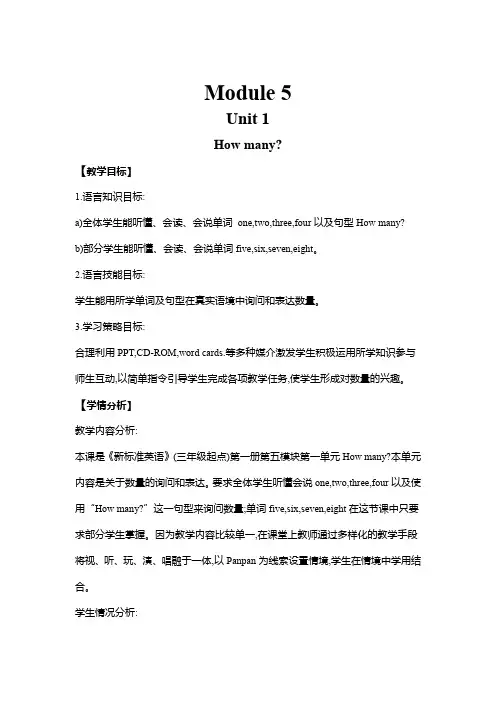
Module 5Unit 1How many?【教学目标】1.语言知识目标:a)全体学生能听懂、会读、会说单词one,two,three,four以及句型How many?b)部分学生能听懂、会读、会说单词five,six,seven,eight。
2.语言技能目标:学生能用所学单词及句型在真实语境中询问和表达数量。
3.学习策略目标:合理利用PPT,CD-ROM,word cards.等多种媒介激发学生积极运用所学知识参与师生互动,以简单指令引导学生完成各项教学任务,使学生形成对数量的兴趣。
【学情分析】教学内容分析:本课是《新标准英语》(三年级起点)第一册第五模块第一单元How many?本单元内容是关于数量的询问和表达。
要求全体学生听懂会说one,two,three,four以及使用“How many?”这一句型来询问数量;单词five,six,seven,eight在这节课中只要求部分学生掌握。
因为教学内容比较单一,在课堂上教师通过多样化的教学手段将视、听、玩、演、唱融于一体,以Panpan为线索设置情境,学生在情境中学用结合。
学生情况分析:与低年级相比,三年级学生仍保留着活泼好动的特性,他们在课堂上和教师的配合度也更高。
但由于三年级学生本学期才刚刚开始接触英语,掌握的单词量很有限,所以整节课使用最简短的教学指令与之互动,通过由易到难的趣味活动展开教学,培养学生对学习数量的兴趣。
【教学重难点】重难点:1.教学重点:学生能运用句型“How many?”询问数量,正确运用单词one,two,three,four回答。
2.教学难点:three的发音;学生能不按顺序认读数字并能够运用所学的单词和句型进行交流。
【教学过程】4.1 step1.Warming upand leading in(热身导入)step2.Presentation(新知呈现)Step3.Practice an consolidation(巩固操练)Step4.Summery(课堂小结)Step5.Homework(作业布置)4.1.1教学活动活动1【导入】热身导入评论step1.Warming upand leading in(热身导入)1.Greetings.师生互致问候。
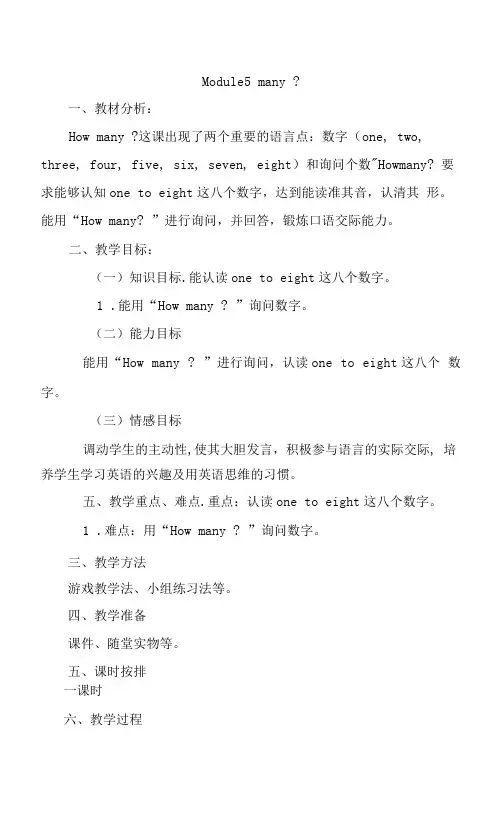
Module5 many ?一、教材分析:How many ?这课出现了两个重要的语言点:数字(one, two, three, four, five, six, seven, eight)和询问个数"Howmany? 要求能够认知one to eight这八个数字,达到能读准其音,认清其形。
能用“How many? ”进行询问,并回答,锻炼口语交际能力。
二、教学目标:(一)知识目标.能认读one to eight这八个数字。
1.能用“How many ? ”询问数字。
(二)能力目标能用“How many ? ”进行询问,认读one to eight这八个数字。
(三)情感目标调动学生的主动性,使其大胆发言,积极参与语言的实际交际, 培养学生学习英语的兴趣及用英语思维的习惯。
五、教学重点、难点.重点:认读one to eight这八个数字。
1.难点:用“How many ? ”询问数字。
三、教学方法游戏教学法、小组练习法等。
四、教学准备课件、随堂实物等。
五、课时按排一课时六、教学过程Stepl: Warming up: “Good morning, boys and girls . I f m Ms are you?9, *复习上节课学习过的单词。
1.老师领读。
How many 多少One-, two 二three fourfiv 五e, six 六,seven 七,eight 八2.开火车读。
3.小组齐读。
4.全班齐读。
Step 2: teaching1.Listen, point and say⑴请生翻译中文意思。
(2)请生领读。
(3)请生听录音并跟读,然后思考:这几只可爱的兔子在做什么?(4)游戏教学法。
(巩固one to four)(5)再次领读。
(6)学生教读。
2.Listen , point and find "one" to“ eight” .(1)老师领读课文。
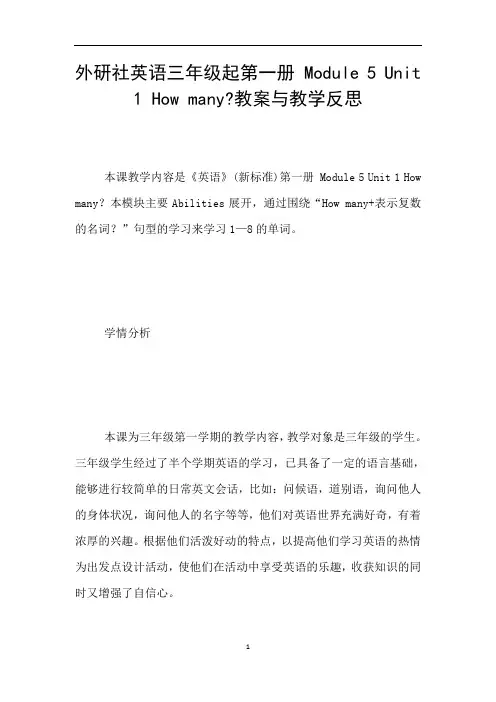
外研社英语三年级起第一册 Module 5 Unit1 How many?教案与教学反思本课教学内容是《英语》(新标准)第一册 Module 5 Unit 1 How many?本模块主要Abilities展开,通过围绕“How many+表示复数的名词?”句型的学习来学习1—8的单词。
学情分析本课为三年级第一学期的教学内容,教学对象是三年级的学生。
三年级学生经过了半个学期英语的学习,已具备了一定的语言基础,能够进行较简单的日常英文会话,比如:问候语,道别语,询问他人的身体状况,询问他人的名字等等,他们对英语世界充满好奇,有着浓厚的兴趣。
根据他们活泼好动的特点,以提高他们学习英语的热情为出发点设计活动,使他们在活动中享受英语的乐趣,收获知识的同时又增强了自信心。
教学目标1、知识目标:(1)语法:学生能够明白在英语中,how many 后面接的是复数名词。
(2)三会单词及词组:one, two, three, four, five, six, seven, eight,how many(3)学生能够听懂、会说、会读日常交际用语“How many+表示复数的名词?2、能力目标:学生能用“How many+表示复数的名词? ”询问物品的数量和8以内的回答。
3、情感目标:培养学生日常用语的应用能力及团结协作的精神,提高英语学习的兴趣。
教学重点和难点重点:学生能够对新词汇(one, two, three, four, five, six, seven, eight,how many)进行听,说,读训练。
难点:学生能够听懂,会说,会读句型(How many…?)及其回答。
设计意图Step1 Warm-up Sept 2.Lead-inSept 3PresentationStep 4 PracticeStep 5 Text learningStep 6ConsolidationStep 7 Homework1、Greetings2、播放音乐 Please stand up 课件T: Now, let’s sing and do the actions.引导学生边唱边做动作。
Module1 Unit1 参考教案一、教学内容外语教学与研究出版社(一起点)三年级上册第一模块Unit 1 Do you use chopticks in the UK?二、教学过程建议(一)热身导入1.教师展示SB Unit 1活动1的挂图,并出示课前整理的二年级上学期所学韵句的图片,然后请学生选择哪些韵句与今天学习的内容相关。
学生自选韵句后,教师将韵句中含有“rice,noodles,meat”的语句写在黑板上,帮助学生复习巩固。
然后请全班学生一起说一说选中的韵句。
2.请学生继续观察挂图,理解语境:Daming在吃饭,小狗眼博地盯着桌上的食物,Daming问它想吃米饭还是面条,结果它想吃的是肉。
教师告诉学生这只小狗叫Bob,这学期会经常出现在导入活动中。
3.播放SB Unit 1活动1的动画或录音,请学生全班跟读、小组跟读、个人跟读。
教师使用图片、单词卡片等教具,带领学生学习单词“want”。
这是要求运用的词汇,这里可简单进行运用训练,在活动2中再进一步巩固。
4.请学生两人一组分角色朗读并表演课文。
(二)任务呈现1.教师告诉学生:“升入三年级后我们要更积极地参与学校的活动。
目前学校希望了解大家对于营养餐的需求。
我们要先认真学习本单元的内容,学完之后,就可以在班级内展开调查啦!”(三)课文学习1.播放SB Unit 1活动2的动画或录音,请学生看动画或边听录音边看挂图,教师帮助学生理解课文语境。
2.再次播放录音,请学生完整地听一遍录音,进一步理解课文并回答问题: What do Amy and Daming eat at the park? Does Amy know how to use chopsticks? What does she use in the UK?3.播放第三遍录音,逐句停顿,请学生跟读。
对于较难的语句,教师可先带读生词,然后按照意群、节奏带读完整的句子,同时请学生注意模仿语音语调。
新版外研版(一起)小学英语三年级上册全册教案Module 1 Unit 1: Do You Use Chopsticks in England?In this unit。
Ms。
Smart。
Amy。
and Daming go out to have fun。
On the way。
Amy gets hungry。
XXX。
because Amy is used to using a knife and fork to eat in England。
she has a hard time using XXX.XXX:Language n: XXX.Grammar Knowledge: Do you use chopsticks in England?Listening: Students can understand the words: use。
chopsticks。
hard。
people。
knife。
fork。
easy.Speaking: Students can say the words: use。
chopsticks。
hard。
people。
knife。
fork。
easy.Reading: XXX read the words in the text: use。
chopsticks。
hard。
people。
knife。
fork。
easy.Writing: Students can write the words: use。
chopsticks。
hard。
people。
knife。
fork。
easy.Language Listening: Students XXX.Skill Speaking: Students XXX related to Chinese and Western customs。
such as "Do you use chopsticks in England?" and "No。
小学英语新外研版(一起)三年级上册第五模块课时备课卡课时备课卡1. Vocabulary: 出示单词卡片,学生快速认读。
2. Make sentences:学生用can造句并译成汉语。
III. Presentation1. Lead inT:刚才大家造的句子中can是什么意思啊?表示的是什么?S:can的意思是“能”,表示的是“能力”。
T:大家说得可真好。
Can除了表示能力之外,还有别的用法,今天我们就来学习,看看Amy是怎么用这种用法来跟妈妈说话的。
请大家看挂图,你能猜出它是什么意思吗?2. New teaching第一遍听音T:Now, let’s look at the picture, and listen to the tape,看看你都听到什么了?S:(看挂图,听录音,说说大意。
)Amy生病了,她问妈妈她可以喝水、看电视、吃冰淇淋吗?第二遍听音T:Amy是怎么用英语来提问的呢?让我们再听一遍录音。
同时,请大家用笔画出Can I …?的句子。
S:一边听,一边画出书中的句子。
听音结束后,学生汇报自己画的句子。
指导学生学习新单词:ill, shop, biscuit。
操练作为“能力”的用法进行初步的复习。
2、教师板书重点的功能句:Can I have a drink, please? Yes, you can. HereNo, I can’t.教学反思模仿性操练中,先让学生观看幻灯片,再模仿表演,学生有了可熟入性学习,自然能很好地进行模仿。
巩固性操练中,我注重了让学生自由交流,使学生口语交际水平得以扩展,知识面得以拓宽。
课时备课卡Ss make sentences. T: Can he/she …? Ss: Yes, he/she can.No, he/she can’t.3. T: In classroom, I can read a book. But I can’t run. Can you say some sentences like this?Ss make sentences.4. T: I ‘m thirsty. Can I have a drink, please? (板书)T encourages Ss to answer: Yes. Here you are.Repeat this activity several times.T: Can I run in classroom?Ss: No, you can’t. (板书)5. T: I have a shop. There are so many things here. Look!T shows pictures, Ss practice in pairs.Can I have …?Yes. Here you are.No, you can’t.Step3. Presentation1. T shows a picture of Amy.T: Today, Amy can’t go to school. What’s wrong with her?Can you guess?Amy is ill.T: If you are Amy and you’re ill. What do you want?Can you ask some questions?Ss: Can I …?2. Listen to the CD-Rom, and find the questions.3. Listen again. This time circle “can” and “can’t”.4. Listen for the third time. This time listen, point and imitate.5. Ss read themselves. Then fill in the blanks. 1、T show the picture of the classroom.。
Module 5 Unit 1 How many? 第一课时教学设计一、教材分析二、How many这一课是新课程标准(三年级起点)第一册第五模块第一单元第一课时的内容,主要让学生学习数字1-8以及句型How many……?并能灵活运用。
教师可以通过自编歌谣,游戏等多种注意培养学生学习英语的兴趣和创新思维,力争达到课堂教学最优化。
教师可以通过让学生数自己的各种文具,数同学或朋友的物品,数身边的人物或事物,以及做简单的数学运算提来练习数字。
因为这是,只要求学生会数数,会用How many…询问物品的数量,不必说出物品名称。
三、学生分析本课的教学对象是三年级的学生,他们刚刚接触英语,对英语充满了好奇心,学习英语的热情高,个性活泼好动,爱表现自己,但注意力不集中,容易分散。
因此,我通过歌曲、游戏、chant等多种形式,激发学生学习英语的兴趣,培养他们英语学习的积极态度,使他们建立初步的学习英语的自信心。
四、教学目标(一)知识目标1.能听懂会说出数字1-8的英语表达2.能用“How many…”询问事物的数量及其回答(二)能力目标1.能用“How many…”对物品的数量进行询问2.能在实际情景中运用1-8这八个数字单词(三)情感目标培养学生学习英语的兴趣,培养学生的参与意识和合作能力五、教学重点、难点(一)教学重点1.能听说、认读数字单词1-82.能用句型“How many…”询问事物的数量及其回答(二)教学难点1.数字1-8以及句型How many…的灵活运用2.正确掌握three 和five的读音,尤其是th/θ/和v/v/的发音五、教具准备点读笔,配套的教学录音带,单词卡,多媒体课件,磁铁等六、教学方法任务型教学法、情景教学法、游戏教学法等。
七、教学过程Step 1、Warming up1、Greetings2、Sing a song: “Please stand up.”(师生边做动作边唱)设计意图:通过问候,歌曲等活动,增进师生之间的情感交流,营造轻松愉快的英语氛围,使学生迅速进入到英语学习的状态。
小学英语新外研版(一起)三年级上册
外研版(一起)三年级上册英语
Module 5 Unit 1 Can I have an ice cream?
一、教学目标与要求
1.知识与能力目标
能熟练掌握短语have a drink, have an ice cream, have a cake。
能初步运用句型Can I have …?Yes, you can. No, you can’t.进行交流,能替换短语进行对话练习。
在实际生活中,运用本节课学习的语句,请求别人允许自己做某事,并根据情况做出相应的肯定或否定回答。
2.情感态度目标
在所创设的情境中,培养学生的合作意识,让学生体验到合作的愉快,鼓励学生大胆的表达自己真实的意愿。
二、教学重点及难点
1.本课的教学重点是重点单词、句子的听、说、读、写。
2.本课的教学难点是对a, an, some的区分、运用和对人称转换的掌握。
三、课前准备
1.教师自己制作的课件和教材的配套光盘。
2.drink, , have a drink, have a cake的卡片。
3.教师准备半瓶饮料、一块蛋糕等小食品。
4.教师准备一个Bingo图表。
5.学生准备一些食物。
四、教学过程
Step 1:Warm up
(1) TPR
教师边说单词边做动作run, jump, swim, fly, sing,学生根据自身的情况会做的边做边说I can…不会做的边做边说I can’t…如:
T : Look. Run run I can run. Can you run? Please stand up, show me.
Ss : I can run.
T : Swim swim.
Ss : I can swim.\ I can’t swim.
…
T : Can yo u sing the song “Row Your Boat”?
Ss : Yes, I can.
(2) Sing the song “Row Your Boat” together.
Step 2:Presentation and practice
(1)Learn the phrase: have a drink.
教师做出口渴的样子,并且说Oh, I’m thirsty. Can I have a drink, please? 教师喝一点饮料后,问学生Do you want to drink?
Re ad the word “drink”. (Show the card “drink”.)
Read the phrase “have a drink” in groups. (Show the card “have a drink”.) Translate it in Chinese.
(2)Use the real drink to teach the sentences:
Can I have a drink, please? Yes, you can. No, you can’t.
问学生谁想喝饮料Who wants to have a drink? 鼓励学生用Can I have a drink, please?来询问,对表达清楚的学生,教师说Yes, you can.并给他一小杯饮料。
当给第三个学生倒饮料时,饮料瓶子(不透明)空了,教师趁机说No, you can’t. I’m sorry. It’s empty.
Read the sentences.
(3)Learn the phrase: have a cake
What’s this? / What are they? 教师拿起蛋糕问学生Are they sweets?学生说Yes, they are.。
T : Show me your cake. Can I have a cake, please?
Ss : Yes, you can.
The teacher has a cake and asks “Can I have a drink, please?”.
Ss : Yes, you can.
The teacher has a drink.
Read the phrase “have a cake” in groups. (Show the card “have a cake”.)
Read the sentences on the blackboard:
Can I have a drink , please?
have a cake
Yes, you can.
No, you can’t.
(4) 让学生带着问题What can Amy have?看课文的配套光盘,并回答问题。
(5)Read the dialog.
Read it together then practice in pairs. (Feedback)
Step 3: Consolidation and extension
(1) Get the food from the teacher using the sentences.
教师拿出一些食物,让学生用Can I have…, please?句型来询问,表述准确的就给他相应的食物。
再找一个学生代替教师发放食物,教师观察学生们的问答是否准确,并帮助学生及时改正错误。
(2) Read some sentences on the screen, sum up the differences of a, an and some.
通过读句子Can I have an apple, please? Can I have an ice cream, please? Can I have some sweets, please? …让学生发现句子中的不同之处,告诉学生复数名词前用some表示一些,单数名词要观察开头字母,开头字母是元音字母的要用an表示一个,开头字母不是元音字母的要用a表示一个。
(3) Get the food in groups.
在小组里,让学生使用自己带的食物,进行问答练习。
(Feedback)
(4) Play the game: Bingo.
教师准备一个4X4的表格,在每个格里贴一种食物的图片(单、复数都有),在每个食物图片的背面都画着一个笑脸或哭脸,当学生用句型Can I have…, please?询问时,教师把学生所说的那种食物的图片翻过来,如果是笑脸,就引导全班学生齐回答Yes, you can.如果是哭脸,就引导全班学生齐回答No, you can’t.男女生轮番提问,谁能先翻出四个连成一排的笑脸,谁就喊Bingo从而获得了胜利。
Step 4: Summary
Read the sentences on the blackboard and review the sentences structures.
Step 5: Homework
(1)Try to act the dialog on page 26-27.
(2)Finish the exercises in the activity book. Step 6: Blackboard design:
Module 5 Unit 1
Can I have a drink , please?
have an ice cream
have a cake
Yes, you can.
No, you can’t.。